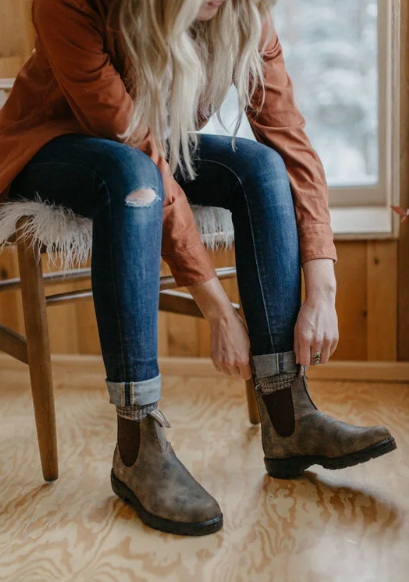Content Menu
● Understanding Chelsea Boots
● The Break-In Process
● Factors Influencing the Break-In Time
● Tips for Breaking In Leather Chelsea Boots
>> 1. Choose the Right Size
>> 2. Wear Them at Home
>> 3. Use Leather Conditioner
>> 4. Utilize Boot Stretchers
>> 5. Heat Treatment
>> 6. Moisture Method
>> 7. Stuffing Technique
● Additional Tips and Techniques
>> 1. Boot Bends
>> 2. Experiment with Lacing
>> 3. Heel Pads and Inserts
>> 4. Wear Rotation
>> 5. Proper Storage
● Common Mistakes to Avoid
>> 1. Rushing the Process
>> 2. Ignoring Discomfort
>> 3. Using Harsh Methods
>> 4. Overlooking Maintenance
>> 5. Wearing Wet Boots
● Signs Your Boots Are Properly Broken In
● Maintaining Your Chelsea Boots After Break-In
● Conclusion
● FAQs
>> 1. How long does it take to break in Chelsea boots?
>> 2. Can I use water to break in my Chelsea boots?
>> 3. Is it necessary to use a leather conditioner?
>> 4. What should I do if my Chelsea boots are still uncomfortable after breaking them in?
>> 5. Are there any risks associated with breaking in leather boots?
● Citations:
Breaking in a new pair of leather Chelsea boots can be a daunting task, especially if you're eager to wear them comfortably. Chelsea boots are not only stylish but also versatile, making them a staple in many wardrobes. However, the stiff leather can lead to discomfort if not properly broken in. This comprehensive guide will walk you through effective methods to break in your Chelsea boots while ensuring they maintain their shape and quality.

Understanding Chelsea Boots
Chelsea boots are ankle-high, close-fitting boots with an elastic side panel, making them easy to slip on and off. They are typically made from leather or suede and can be dressed up or down depending on the occasion. However, the leather's rigidity can cause discomfort during the initial wears.
The Break-In Process
The break-in period for leather Chelsea boots varies based on the quality of the leather and how often you wear them[6]. Generally, it can take anywhere from a few days to a few weeks for the leather to soften and mold to your feet[6]. High-quality leather boots, made with thick leather, may require around 80-120 hours of active wear to fully break in[6].
Factors Influencing the Break-In Time
Several factors can affect how long it takes to break in your Chelsea boots:
- Leather Quality: Higher quality leather may be more durable but also stiffer initially.
- Frequency of Wear: Consistent wear, even in short bursts, helps the leather to soften and mold.
- Environmental Conditions: Exposure to moisture and temperature changes can impact the leather's pliability.
- Care Practices: Regular conditioning and proper storage can influence the break-in process[10].
Tips for Breaking In Leather Chelsea Boots
1. Choose the Right Size
Before you even purchase your Chelsea boots, ensure you select the correct size[12]. A snug fit is essential, but they should not feel overly tight[12]. When trying on boots, wear the type of socks you plan to use with them. It's best to try them on in person to ensure the right fit, as every foot is different[12].
2. Wear Them at Home
One of the simplest ways to break in your Chelsea boots is to wear them around your home[11]. Start with short periods and gradually increase the time as they begin to soften[11]. This allows the leather to adjust to the contours of your feet without the added stress of outdoor wear.
- Tip: Wear thick socks to create extra friction and help stretch the leather slightly[13]. Doubling up on socks can also help reduce space inside the boot, putting more tension on the leather[13].
3. Use Leather Conditioner
Applying a high-quality leather conditioner can help soften the leather[1][10][11]. This product nourishes the material, making it more pliable and preventing it from drying out[1][14].
- Method: Apply a thin layer of conditioner evenly across the boot using a soft cloth[1]. Allow it to absorb for several hours or overnight before wearing[1]. Wonder Balsam is also a great option for softening leather[9].
4. Utilize Boot Stretchers
Boot stretchers are effective tools designed to widen specific areas of your boots that may feel too tight[3][13]. They can help stretch the leather without causing damage.
- How to Use: Insert the stretcher into your boot and turn the handle until it applies gentle pressure[3]. Leave it overnight for optimal results[3].
5. Heat Treatment
Applying gentle heat can make the leather more pliable[3][9]. This method should be used cautiously to avoid damaging the leather[3].
- Method: Use a hairdryer on a low setting while wearing thick socks and your boots[3]. Move the dryer back and forth over areas that feel tight for about 30 seconds at a time, then walk around as they cool down[3]. Alternatively, place your boots in a small heated room for 10-15 minutes[9].
Caution: Avoid overheating as this can damage the leather, causing it to dry out and become brittle[3][12].
6. Moisture Method
A slightly damp method can help mold the boot to your foot shape without causing damage[3]. The moisture makes the leather more pliable[3].
- Method: Lightly dampen a cloth and wipe down the insides of your boots—do not soak them! Then wear them with thick socks until they dry[3]. Another approach is wearing damp socks with your boots for a short period[3].
7. Stuffing Technique
When you're not wearing your boots, stuff them with newspaper or socks to help maintain their shape and gently stretch the leather[13]. This prevents the leather from creasing and helps retain the boot's form[3].
Additional Tips and Techniques
1. Boot Bends
Flexing the boots by hand can help to soften the leather and encourage flexibility[1].
- Method: Wipe the boots with a clean, damp cloth or conditioner to soften them up[1]. Use your hands to gently flex the boot shaft back and forth[1]. Focus on the bend points where your foot naturally flexes[1].
2. Experiment with Lacing
While Chelsea boots don't have laces, this tip is useful for other types of leather boots. Experimenting with different lacing techniques can relieve pressure points[1].
3. Heel Pads and Inserts
Using heel pads can provide extra comfort, especially in the heel area[9]. Insoles and shoe inserts can also provide additional support while breaking in your boots[3].
4. Wear Rotation
Alternate between different pairs of boots to allow each pair sufficient time to air out and recover[7]. Boots ought to be given sufficient time to recover after wear, and a period of 1 day's rest is recommended[10].
5. Proper Storage
Store your boots in a cool, dry place away from direct sunlight[3]. Use shoe trees to help maintain their shape and absorb moisture[2][10].

Common Mistakes to Avoid
1. Rushing the Process
Trying to break in your boots too quickly can cause pain and discomfort and may even damage the leather[3]. Be patient and allow the leather to soften gradually[3].
2. Ignoring Discomfort
Ignoring discomfort in hopes that it'll magically disappear is a common mistake[1]. Address any pain or rubbing immediately by using thicker socks or applying boot conditioner[1].
3. Using Harsh Methods
Avoid using harsh methods like soaking your boots in water or using excessive heat, as this can permanently damage the leather[3][12].
4. Overlooking Maintenance
Neglecting regular cleaning and conditioning can lead to the leather drying out and cracking[2][7][14].
5. Wearing Wet Boots
Wearing wet or damp boots can reduce the ability of the waterproof lining to keep your feet dry[2]. Allow them to dry naturally before wearing them again[2].
Signs Your Boots Are Properly Broken In
- Comfort and Flexibility: The boots should feel comfortable and allow for natural movement[3].
- Reduced Stiffness: The leather should be noticeably softer and more pliable.
- Custom Fit: The boots should mold to the shape of your feet, providing a snug and supportive fit.
- No Discomfort: You should be able to wear the boots for extended periods without experiencing pain or blisters.
Maintaining Your Chelsea Boots After Break-In
Once your Chelsea boots are broken in, proper maintenance is crucial to prolong their lifespan:
- Regular Cleaning: Clean dirt and dust from your boots regularly using a soft brush or cloth[7][14].
- Conditioning: Apply leather conditioner every few months to keep the leather supple[11][14].
- Waterproofing: Use a waterproofing spray or wax to protect your boots from water and salt damage[14].
- Proper Storage: Store your boots in a cool, dry place with shoe trees to maintain their shape[2][10].
- Professional Care: Consider taking your boots to a professional cobbler for repairs and maintenance[3].
Conclusion
Breaking in leather Chelsea boots requires patience and care, but with these methods, you can ensure that your boots become comfortable companions for years to come. Remember that every pair is unique; what works for one may not work for another, so be prepared to try different techniques until you find what suits you best. The key is to be gentle, consistent, and attentive to the needs of your leather boots. With the right approach, you'll be enjoying the comfort and style of your Chelsea boots for many years.

FAQs
1. How long does it take to break in Chelsea boots?
The break-in period typically lasts from a few days to several weeks, depending on how often you wear them and their initial stiffness[6]. High-quality leather boots may require around 80-120 hours of active wear to fully break in[6].
2. Can I use water to break in my Chelsea boots?
While lightly dampening the interior can help mold them to your feet, soaking them is not recommended as it may damage the leather[3][12]. Excessive moisture can dry out the leather and cause it to crack[12].
3. Is it necessary to use a leather conditioner?
Using a leather conditioner is beneficial as it softens and nourishes the material, making breaking in easier and prolonging the life of your boots[1][10][11][14]. It prevents the leather from drying out and cracking.
4. What should I do if my Chelsea boots are still uncomfortable after breaking them in?
If discomfort persists after trying various methods, consider consulting a professional cobbler who can stretch or adjust them properly[3]. Heel pads and inserts can also provide additional comfort[9].
5. Are there any risks associated with breaking in leather boots?
Yes, improper techniques such as excessive heat or moisture can damage the leather or alter its shape permanently[3][12]; always proceed with caution[3]. Avoid rushing the process and using harsh methods[3][12].
Citations:
[1] https://www.overlookboots.com/blogs/boots/how-to-break-in-new-boots-the-right-way-dos-and-donts
[2] https://www.grisport.co.uk/shoe-care-guide-i111
[3] https://www.ayrequestrian.com/blogs/news/how-break-in-riding-boots
[4] https://www.overlookboots.com/blogs/boots/how-to-stretch-leather-boots
[5] https://www.youtube.com/watch?v=DPHb60sjUi0
[6] https://drewsboots.com/blogs/news/how-to-break-in-leather-boots
[7] https://www.vdp.com/EN/Nieuws/date/desc/1/2726/0/11-maintenance-tips-to-keep-your-work-shoes-in-good-shape.html
[8] https://www.youtube.com/watch?v=4FKgPJMME1M
[9] https://nushoe.com/break-in-dr-martens-chelsea-boots/
[10] https://www.fieldandmoor.co.uk/pages/essential-footwear-care
[11] https://www.wynsors.com/blog/how-to-soften-stretch-leather-shoes-at-home/
[12] https://www.heddels.com/2019/03/dos-donts-breaking-new-pair-leather-boots/
[13] https://www.youtube.com/watch?v=oxyONrK1lpM
[14] https://bakershoe.com/blogs/news/the-complete-leather-boot-care-guide
[15] https://jhuti.com/blogs/advice/breaking-in-leather-boots
[16] https://www.rei.com/learn/expert-advice/breaking-in-hiking-boots.html
[17] https://www.clarks.com/en-us/blog/editorial/how-to-break-in-new-shoes
[18] https://www.dcleaners.com/blog/put-your-best-foot-forward-how-to-keep-your-boots-looking-brand-new/
[19] https://www.londondaily.news/genius-hacks-to-break-in-new-boots-pain-free/
[20] https://www.timberland.co.uk/en-gb/customer-care/product-faqs/how-to-stretch-and-soften-leather-footwear
[21] https://stridewise.com/how-to-break-in-boots/
[22] https://www.heddels.com/2019/03/dos-donts-breaking-new-pair-leather-boots/
[23] https://www.reddit.com/r/Boots/comments/1eodv5v/how_to_take_care_of_my_new_leather_boots/
[24] https://www.reddit.com/r/goodyearwelt/comments/r5p3f8/gyw_faq_breakingin_shoes/
[25] https://www.reddit.com/r/IBEW/comments/16cnlql/advice_on_how_to_make_boots_more_comfortable_or/
[26] https://www.mountainwarehouse.com/expert-advice/how-to-break-in-walking-boots/
[27] https://www.instagram.com/thechelseabootstore/p/DEPYOtltzNp/
[28] https://www.youtube.com/watch?v=WYJdIsf0Ckk
[29] https://drewsboots.com/blogs/news/caring-for-leather-work-boots
[30] https://www.overlookboots.com/blogs/boots/how-to-break-in-new-boots-the-right-way-dos-and-donts
[31] https://www.airr.com.au/2023/11/10/how-to-break-in-chelsea-boots/
[32] https://www.tiktok.com/discover/how-to-break-in-chelsea-boots
[33] https://www.rmwilliams.com/uk/care-guides/maintaining-your-boots.html?lang=en_GB
[34] https://www.vionicshoes.com/blog/how-to-break-in-leather-boots/
[35] https://www.facebook.com/ChelseaBootStoreShoeShop/photos/breaking-in-your-new-chelsea-boots-a-step-by-step-guide-struggling-to-break-in-y/1163951015176245/
[36] https://www.youtube.com/watch?v=iKzN872g0gM
[37] https://www.youtube.com/watch?v=R0EGWrsVzEI
[38] https://www.internationalleatherclub.com/how-to-break-in-leather-boots/
[39] https://www.youtube.com/watch?v=3SD7ltcWLeg

















